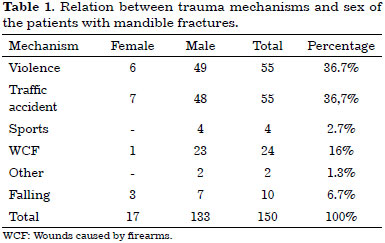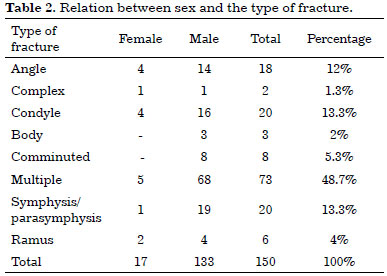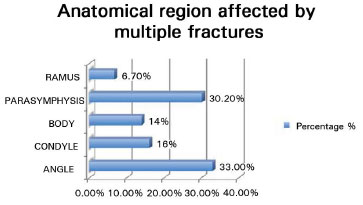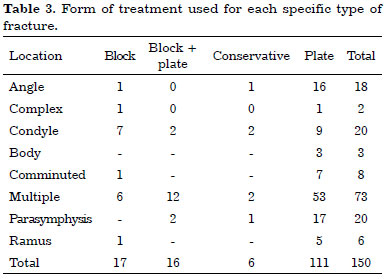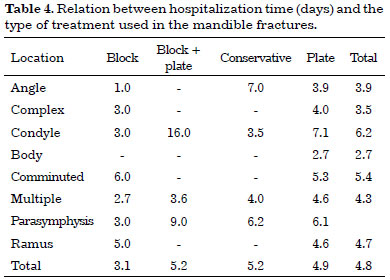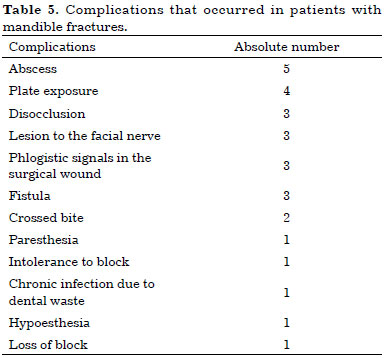ABSTRACT
INTRODUCTION: Mandible fractures are the second most frequent type of facial injury according to most studies. However, the epidemiological data on mandible fractures may vary between countries, or according to the trauma mechanism and the period of injury evaluation, owing to the influence of cultural, technological, environmental, and socioeconomic factors. This type of trauma comprises an important cost and morbidity factor. The aim of this study was to outline the epidemiological profile of mandible fractures treated at the Cajuru University Hospital from 2010 to 2013.
METHODS: A retrospective, descriptive, observational study was performed with 236 patients hospitalized in the Cajuru University Hospital, from January 2010 to July 2013, in whom mandible fracture was diagnosed. Only patients with complete records were included in the study, resulting in a total of 150 patients.
RESULTS: From the 150 records analyzed, it was found that mandible fractures were more prevalent in males, and the average age of patients was 29.9 years. Concerning the trauma-causing mechanisms, the most common were interpersonal violence (36.7%), traffic accidents (36.7%), and wounds caused by firearms (16%). Plate and screw fixation was the most frequently used treatment (111 patients).
CONCLUSIONS: Mandible fractures were mainly caused by interpersonal violence, and were more frequent in young males. Multiple fractures were present in almost half of the patients. In single fractures, the condyle and parasymphysis regions were the most affected. Open treatment was most commonly performed, with reconstruction with a titanium plate being the most common approach.
Keywords:
Mandible; Maxillomandibular fracture; Face; Treatment.
RESUMO
INTRODUÇÃO: As fraturas mandibulares correspondem ao segundo tipo de lesões faciais mais frequentes na maioria dos estudos. Contudo, os dados epidemiológicos desta fratura podem variar conforme o país, o mecanismo de trauma e a época em que foram avaliadas, uma vez que são influenciadas por fatores culturais, tecnológicos, ambientais e socioeconômicos. Consistem em importante fator de custo e morbidade. Delinear o perfil epidemiológico dos casos de fratura de mandíbula tratados no Hospital Universitário Cajuru no período entre 2010 e 2013.
MÉTODO: Foi realizado um estudo retrospectivo, observacional e descritivo de 236 pacientes internados no Hospital Universitário Cajuru, no período de janeiro de 2010 a julho de 2013, diagnosticados com fratura de mandíbula. Foram incluídos no trabalho apenas os pacientes que apresentavam os prontuários contendo informações completas, totalizando 150 pacientes.
RESULTADOS: Dos 150 prontuários analisados, encontrou-se prevalência das fraturas de mandíbula no sexo masculino, média de idade de 29,9 anos. Em relação ao mecanismo de trauma, as mais comuns foram a agressão interpessoal (36,7%), acidentes automobilísticos (36,7%), ferida por arma de fogo (16%). Com relação ao tratamento, o uso de placa e parafuso foi a forma mais realizada (111 pacientes).
CONCLUSÕES: As fraturas de mandíbula são causadas principalmente por agressão interpessoal, são mais incidentes em homens e jovens. As fraturas múltiplas estão presentes em quase metade dos pacientes. Nas fraturas únicas, a região do côndilo e parassínfise foram, ambas, as mais acometidas. O tratamento cruento foi o mais empregado, sendo a reconstrução com placa de titânio a forma mais comum.
Palavras-chave:
Mandíbula; Fraturas maxilomandibulares; Face; Tratamento.


